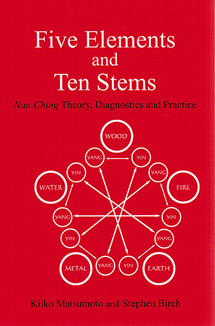
By Kiiko Matsumoto & Stephen Birch
Trade Paperback
ISBN 9780912111353
304 pages
This text makes available the information a student or practitioner needs to add important and powerful treatments to their repertoire. The authors have assembled theoretical explanations and treatment systems based on the use of the eight extraordinary vessels. The information comes from highly successful Oriental scholars and practitioners. The reasoning and research from which these treatment systems are derived is detailed, beginning with the classical descriptions of these vessels as the oceans of qi and blood.
Descriptions of the eight trajectories include starting points, pathways, variant pathways, and branches. Eleven full-page body charts illuminate the text and more than 50 tables summarize the trajectories, the meeting points, and the areas of diagnostic correspondence. Classical extra meridian treatments are set out, with treatment styles that are detailed in step-by-step presentations. Fascinating systems that have been only partially or superficially reported in the West are fully explained. These systems include plus-minus needling, the Chinese system of body zones, the use of bipolar metals, magnets, and electrically pulsed magnets. Sample treatments, illustrations of correspondence and reflex areas, treatment tables, and diagrams provide practical support. There is a major treatment list for the eight master-coupled points, with thousands of indications for the points from Japanese, Chinese, English, and German texts. Organized by body area or specific condition, this reference permits the practitioner to see how the various indications relate to one another and form groups. A final section describes the authors’ experience in combining extraordinary vessel and magnetic treatments with element/stem diagnosis, scar treatment, and zone therapy.
Back Cover:
Using the most recent Japanese and Chinese sources, the authors have prepared the most readable and useful work on the eight extraordinary vessels available in English. This information has been the foundation of powerful classic and modern energetic systems that have consistently achieved truly remarkable results.
The Text Includes:
- Classical Extraordinary Vessel Theory
- Modern Extraordinary Vessel Theory
- Complete Pathway Descriptions
- Classical Acupuncture Therapy
- Action and Effect of the Points
- Asymptomatic Balance Therapies
- Modern Electromagnetic Treatments
The text is fully illustrated and contains a pathway chart for each of the extraordinary vessels, a complete index, bibliography and practical practitioners’ appendixes. A thorough diagnostic and treatment instructions are included for each of the systems discussed.
Praise for Extraordinary Vessels -eBook
“It is a delight to see that there is a return to the original concepts of acupuncture and the movement of energy on a global level, as distinct from the use of points purely for the removal of specific perverse influences.”
-British Journal of Acupuncture
“The authors attempted for the first time in English, a compilation of the major historical literature on the eight extraordinary vessels. The first chapter introduces the basic theoretical model of the extraordinary vessels with some modern extrapolations. The second chapter contains the most comprehensive compilation of all the major historical discussions of the pathways of the extraordinary vessels that can be found in English. The third chapter contains a compilation of the most comprehensive Asian discussions of the indications and treatment targets for the extraordinary vessels from the historical literature in English. The fourth chapter introduces two rather unique modern uses of the extraordinary vessels developed in Japan. The final sections attempt to show parallels between the historical literature and the modern uses, specially TCM. Recently, other texts on the extraordinary vessels have been published, but none have attempted to report in depth from on the historical literature that this text features.”
-Stephen Birch




